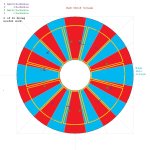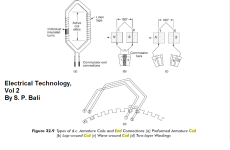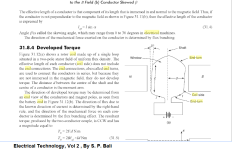kiwifiat said:
Buk___ said:
Of course there is BEMF.
If the field in the coils combine to produce a field in the tooth which completes its magnetic circuit via the magnet, the back-iron, the adjacent magnet(s) and the common core ; why wouldn't the flux flowing around that same circuit, driven by the magnet, act back on the coils?
It does, hence BEMF.
So the rotor flux does interact with the windings then?
The "rotor flux" -- the flux from the magnets -- interacts -- links through -- the tooth core, as a part of the magnetic circuit.
The flux in that magnetic circuit -- when passing through the tooth core in close proximity to the windings -- interacts with them. As the magnets pass by the end of the tooth, the flux in the magnetic circuit varies; waxing and waning in strength as the face of each magnet presents more or less of itself to the face of the tooth; and inverting as the different polarity magnets pass by.
It is this changing flux passing through the tooth, close to the windings, that induces the BEMF in the windings.
kiwifiat said:
My BEMF statement needs to be qualified to if Ke = 0 there can be no torque, a motor with Ke ≠ 0 will generate stall torque at zero rpm.
If you lock the rotor so that it cannot move and then power the windings, then the attraction & repulsion between the fields induced in the teeth, and the (locked) rotor magnets exists, and produces a torque that would be detected pressing against whatever is locking the rotor. No motion needed.
kiwifiat said:
If as you state there is no interaction between rotor flux and the stator windings in a cored motor there can be no BEMF.
I said
direct interaction between the magnets and the windings. The rest is refuted (again) above.
kiwifiat said:
What is your explanation for a coreless motor operation if it doesn't rely on Lorentz forces?
Proximity and imbalance.
Proximity: the windings are in the airgap. As close to the magnet faces as manufacturing tolerances will allow. The coils are very narrow -- just one or a few turn wide axially -- so they are all within a few mm or less of the face of the magnets. Lorentz force is maximised by close proximity.
(In a toothed BLDC, the first (nearest) turns are often (for the Axial flux; always for the ThinGap) further from the magnets than the entire width of coil in the airgap coiled motors; and those furthest away can be 30, 40, 50 mm. )
Unaided, the field strength from the magnets falls of 1/R^3 of the distance. That means that if the field strength of the magnet is down to 50% (and it is much lower) 5mm away, then it will be 50/8 = 6.25% after 10 and 50/27 = 1.85% after 15mm. Its both more complicated and much worse than that, but it serves to illustrate the exponential falloff.
Imbalance: Two cases:
Axial flux: Firstly, air cores/solenoids act like bar magnets, just as wound teeth do, just shorter and fatter. Which is to say, the attraction and repulsion between the individual cores an the adjacent magnets as they align then switch, is just as real and powerful as the tooth/magnet interactions in a toothed BLDC.
There is also, due to proximity, Lorentz force at work. But even this is not so much as you might hope. At the single position documented in the following picture
6 of the 8 sides in one of the powered phases are producing anticlockwise torque and 2 clockwise.
5 of the 8 sides of the second power phase are produce anticlockwise torque and 3 clockwise.
Net state: Of the 16 powered sides, 10 are counterbalancing each other, leaving just 6 to produce useful torque. But rotate it a little, and the balance changes to the exact same 6 of 16 creating torque,
but in the opposite direction.
:

And if you want to step through putting the rotor in (say) 360, 1 degree rotations and adjusting the phases and directions to suit the commutation, the end result is that over a single cycle, the net Lorentz force is going the right way half the time and the wrong way the other half.
You (nor most others) won't believe me, but please try it for yourselves. You don't need to do all 360 1deg positions; stats says that if you do say 40 or 50 at randomly chosen positions, your result will be a very strong indicator of the full result.
Thin gap: If you've ever look closely at the ironless composite stator of a ThinGap motor, you'll see that the copper angles (or chevrons) across the width of the stator. You can just make it out
here and
here if you blow them up and look closely. (It's clearer in the second, chevroned example image.)
In part that is done to reduce cogging, like slanting the slots in a normal bldc; but it also distributes the copper of each individual turn over a much wider area. If you could see through the chevroned stator, and picked out an individual turn, it would look diamond shaped; with one half of the diamong on the outside, and the other on the inside.And the width of that diamond spreads further around the stator than the a single magnet,
The upshot in both angled and chevroned case is, the flux strength affecting one half of each turn on the outside, is markedly different to the flux strength affecting the other side -- say, the edge of the magnet vs. the middle, or the opposing poles of two adjacent magnets. And the bottom line is that there is never a situation where the fields affecting the two halves of any given turn are in balance.
I have (or had) a copy of the ThinGap patent document that describes it in some detail; I'll try to find it.
(The same is true to an extent for normal BLDCs & axial flux motors, but it a quirk (and factor of) the mismatch of poles to teeth; not a fundamental and critical design criteria as with the ThinGap.)






